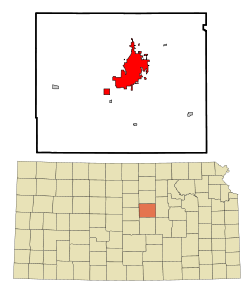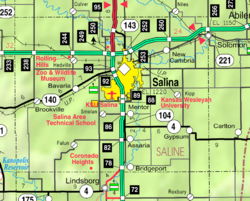Salina, Kansas
| Salina, Kansas | |
|---|---|
| City | |

Water tower in Salina (2013)
|
|
 Location within Saline County and Kansas |
|
 KDOT map of Saline County (legend) |
|
| Coordinates: 38°50′25″N 97°36′41″W / 38.84028°N 97.61139°WCoordinates: 38°50′25″N 97°36′41″W / 38.84028°N 97.61139°W | |
| Country | United States |
| State | Kansas |
| County | Saline |
| Founded | 1858 |
| Incorporated | 1870 |
| Government | |
| • Type | Council-Manager |
| • Mayor | Jon Blanchard |
| • City Manager | Jason Gage |
| Area | |
| • Total | 25.15 sq mi (65.14 km2) |
| • Land | 25.11 sq mi (65.03 km2) |
| • Water | 0.04 sq mi (0.10 km2) |
| Elevation | 1,227 ft (374 m) |
| Population (2010) | |
| • Total | 47,707 |
| • Estimate (2015) | 47,813 |
| • Density | 1,900/sq mi (730/km2) |
| Time zone | CST (UTC-6) |
| • Summer (DST) | CDT (UTC-5) |
| ZIP code | 67401-67402 |
| Area code | 785 |
| FIPS code | 20-62700 |
| GNIS ID | 476808 |
| Website | ci |
Salina /səˈlaɪnə/ is a city in and the county seat of Saline County, Kansas, United States. As of the 2010 census[update], the city population was 47,707. Located in one of the world's largest wheat-producing areas, Salina, also known as the City of Swans, is a regional trade center for north-central Kansas. It is home to multiple colleges.
Prior to European colonization of the area, the site of Salina was located within the territory of the Kansa people. Claimed first by France as part of Louisiana and later acquired by the United States with the Louisiana Purchase in 1803, it was within the area organized by the U.S. as Kansas Territory in 1854. In 1856, a colony led by Preston B. Plumb established the first American settlement near the site at a location on the Saline River.
Settlers led by journalist and lawyer William A. Phillips founded Salina in 1858. During the following two years, the territorial legislature chartered the town company, organized the surrounding area as Saline County, and named Salina the county seat. The westernmost town on the Smoky Hill Trail, Salina established itself as a trading post for westbound immigrants, prospectors bound for Pikes Peak, and area American Indian tribes. The town's growth halted with the outbreak of the American Civil War when much of the male population left to join the U.S. Army.
...
Wikipedia
